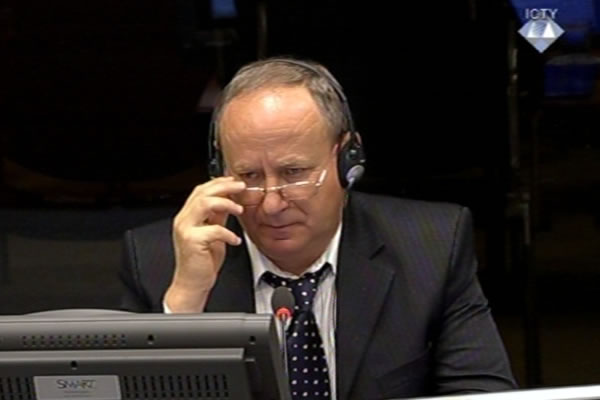Home
WHAT TO DO WITH 23 BALIJAS
Vujadin Stevic nicknamed Dragan testified at the trial of Radovan Karadzic. Stevic admitted that in May 1992 he took part in the arrest of about 20 Muslims in Glogova near Bratunac but denied that he had anything to do with their execution. In his evidence in the prosecution case, Musan Talovic, one of the survivors, said that Stevic asked his superior Najdan Mladjenovic over the radio for instructions ‘what to do with 23 balijas’
 Vujadin Stevic, defence witness of Radovan Karadzic
Vujadin Stevic, defence witness of Radovan Karadzic Through the evidence of Vujadin Stevic, former member of the VRS Bratunac Brigade, Karadzic tried to prove that Serb forces’ operations in Glogova near Bratunac in May 1992 did not have ethnic cleansing as their goal. Karadzic contends that the operations were launched to secure the roads for the JNA withdrawal after the murder of a Serb assembly member, Goran Zekic. After he tendered into evidence the witness’s statement, Karadzic didn’t have any questions for the witness.
In the cross-examination, prosecutor Matteo Costi put it to Stevic that the objective of the Glogova operation was in fact the expulsion of Muslims from that area. The prosecutor confronted the witness with the evidence of Musan Talovic, who survived an execution on 9 May 1992. In his evidence during the prosecution case, Talovic said that he and about 20 other Muslims were captured that day and taken to Glogova. Vujadin Stevic called Dragan ordered them to line up and face the wall of the local shop. Stevic then called his superior Chetnik ‘warlord’ Najdan Mladjenovic over the radio and asked him ‘what to do with 23 balijas’.
Stevic admitted that he was in the unit that transferred the detainees to Glogova and that his baptismal name was Dragan. However, he denied that Mladjenovic ordered him to execute the prisoners. According to Stevic, he ordered Talovic and other prisoners to stand by the wall of the local shop to ‘protect’ them. They were thus ‘sheltered’ by the wall from one side and on the other side they were ‘protected’ by Stevic and other Serb soldiers. Stevic claimed that at the time he didn’t know Mladjenovic at all. The claim prompted the prosecutor to note that before the war both Stevic and Mladjenovic were members of the SDS Municipal Board in Bratunac and carried out party tasks together.
The prosecutor then brought up the witness’s involvement in the VRS operations in Srebrenica in July 1995. On 12 July 1995, Stevic participated in the arrest of the Dutch ‘blue helmets’. The Dutch UN soldiers were taken to the Fontana Hotel in Bratunac. According to Stevic, the objective of the operation was to ‘steer them away from the unfortunate events’. In Stevic’s words, it was a ‘humane act’. If the Dutch soldiers were to meet him again, Stevic was sure they would be as glad to see him as he would be.
As the prosecutor noted, after the ‘humane’ operation Stevic went on searching for the stragglers from the column that had headed out from Srebrenica towards Kladanj through the woods. Stevic argued that his unit was tasked with providing logistical and security support to the HQ in Magasici. Although the place was just a few kilometers away from Kravica, Stevic claimed he didn’t know that about 1,000 persons had been executed there. He didn’t know that their bodies had been buried the next day in the mass graves just a kilometer away from the Serb HQ in Magasici, practically in their back yard.
In the re-examination, Karadzic tried to improve the impression left by the witness. He noted that Stevic had other nicknames apart from Dragan: he was called Cica and Tito. When Karadzic remarked Tito was not a Chetnik nickname, the witness shrugged. ‘It’s not logical, but there you have it’, the witness replied.
Linked Reports
- Case : Karadzic
- 2013-03-25 BOZIDAR VUCUREVIC – ‘PROTECTOR’ OF TREBINJE MUSLIMS
- 2013-03-22 TRUTH AND UNTRUTH ABOUT SREBRENICA
- 2013-03-22 APPELLATE HEARING FOR KARADZIC JUDGMENT ON 17 APRIL 2013
- 2013-03-27 THE WITNESS WHO DIDN’T SEE ANYTHING
- 2013-03-28 STEALING VW GOLF CARS MORE IMPORTANT THAN CRIMES AGAINST CIVILIANS
- 2013-04-02 RADOVAN KARADZIC WAS A ‘SUPERIOR BUT VULGAR INTELLECTUAL’
